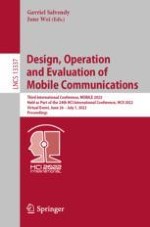2022 | Book
Design, Operation and Evaluation of Mobile Communications
Third International Conference, MOBILE 2022, Held as Part of the 24th HCI International Conference, HCII 2022, Virtual Event, June 26 – July 1, 2022, Proceedings
Editors: Gavriel Salvendy, Dr. June Wei
Publisher: Springer International Publishing
Book Series : Lecture Notes in Computer Science
